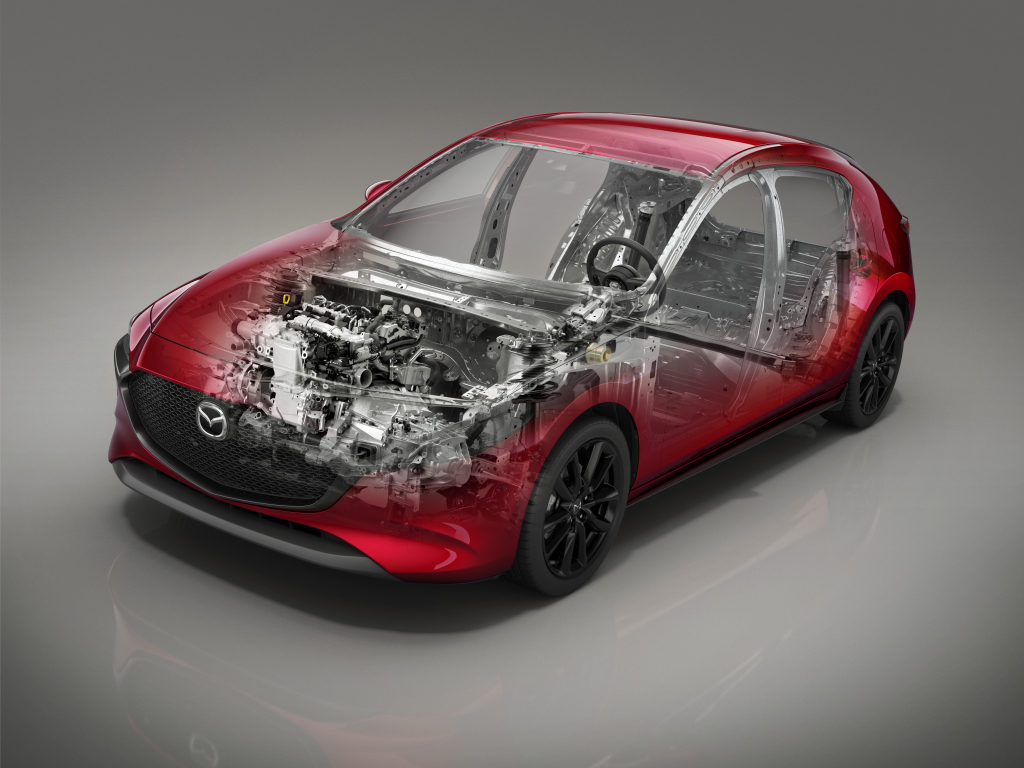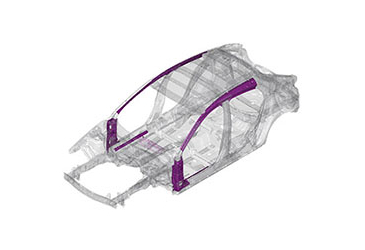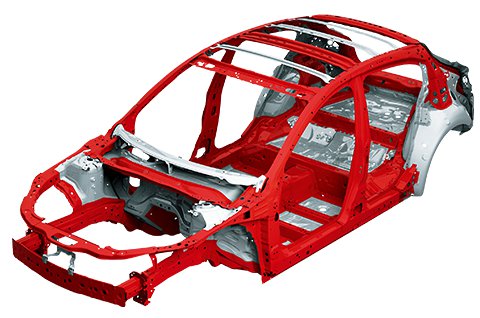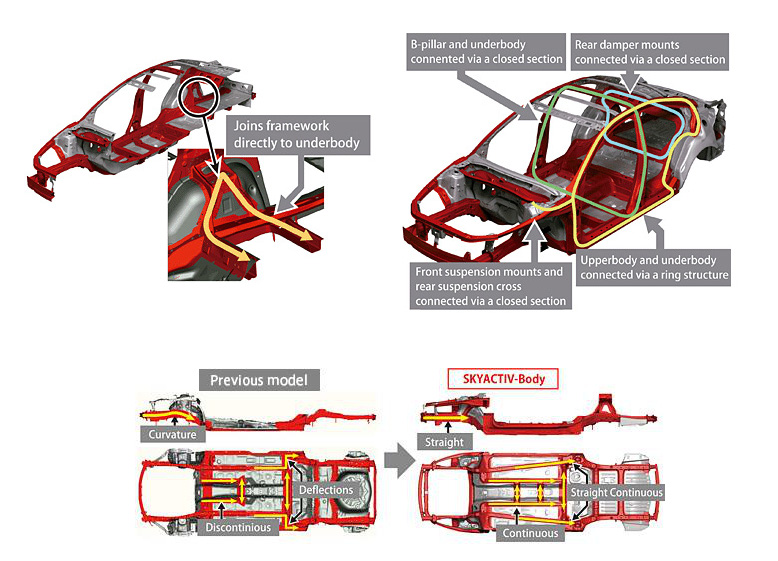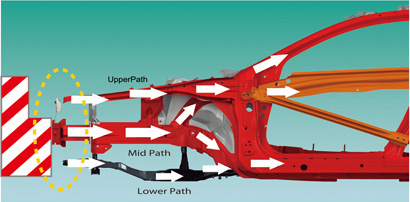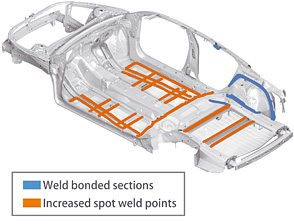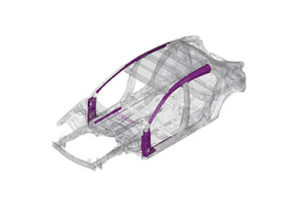
Mazda: 1,310 MPa cold-stamped steel a world first, will appear on new SKYACTIV architecture
By onAnnouncements | Market Trends | Repair Operations | Technology
Mazda earlier this month announced a breakthrough allowing it to produce “the world’s first cold-stamped vehicle body parts made from 1,310 MPa-class high-strength steel.”
Collision repairers will see the steel on Mazdas built on the new SKYACTIV vehicle platform, which Mazda said will spread from the next-generation 2019 Mazda3 to other models.
The 1,310-megapascal steel will join what Mazda reports is 30 percent of the Mazda3 body built from ultra-high-strength steel 980 MPa or higher. The 2018 Mazda3s you’re probably seeing in your shop now had a mere 3 percent of steel at or above the 980 MPa mark.
Mazda in a Jan. 10 news release said prior cold-stamping of “body structural members” could only be done up to 1,180 MPa “due to the material’s formability and the difficulty of ensuring dimensional accuracy after processing.”
Nippon Steel & Sumitomo Metal Corporation and JFE Steel Corporation helped Mazda break this barrier with the 1,310 MPa steel, and it’ll be interesting to see if the metal spreads to competitors also supplied by the steel manufacturers.
The 1,310 MPa steel will appear on the 2019 Mazda3 on what Mazda describes as the “front pillar inner, the roof rail inner, the hinge pillar reinforcement, the roof rail reinforcement, the No. 2 crossmember and the side sill inner reinforcement.” The metal will allow the OEM to save 6.6 pounds of weight.
The explosion of ultra-high-strength steel and the introduction of new, fancy steel grades make it absolutely vital that repairers read the OEM repair procedures. Going from a mere 3 percent of the body at 980 MPa+ to 30 percent means it’s highly likely that a number of 2019 Mazda3 parts will suddenly have repair restrictions not present on the 2018 model. (Because of their crash-protection role and metallurgical properties, higher-strength steels tend to have strict heat and sectioning rules.)
Mazda sold 64,638 Mazda3s in 2018, so you’re likely to see a 2019 model with the new steel appear in your shop. Even if your area is light on Mazda3s, Mazda’s plans to spread the SKYACTIV platform to other models make it likely you’ll encounter the new metal and archtiecture at some point.
SKYACTIV
The SKYACTIV platform itself make some dramatic structural changes that shops must understand to preserve the intended safety and driving experience of next-generation Mazdas built upon it.
“The idea is that protection starts with the strong SKYACTIV body structure, and extends to features such as impact-absorbing materials throughout the cabin, pre-tensioning seat belts and special structures like our impact-absorbing steering column and anti-intrusion brake pedal,” Mazda has written about its safety plans.
“Several times a day, the Mazda Safety Testing Laboratory echoes to the sound of deploying airbags and tortured metal,” Mazda has also written. “Every new model goes through more than 100 different crash tests to ensure that it meets the very highest safety standards. A special truck is slammed into test vehicles at different angles at speeds of up to 55 mph, while cars are also thrust into solid concrete walls and metal posts to simulate the most common collisions. Mazda’s use of high-tensile steel in its SKYACTIV body design has made its cars safer than ever before, but the quest for safety continues.”
A Mazda corporate site reports the platform will be 8 percent lighter but 30 percent more rigid.
A graphic discussing a Mazda6-type car describes what Mazda calls “high-tensile steel” of at least 340 MPa growing from 40 percent to 60 percent of the body. 590 MPa or stronger advanced-high-strength steel grows from more than 20 percent of the body to 40 percent, and ultra-high-strength steel 780 MPa or higher spreads from nearly 10 percent of the body to nearly 20 percent.
Mazda explained that it sought coordination and straightness in designing the platform.
For the basic framework, we adopted the concepts of “straightening”, and a “continuous framework” in which each section functions in a coordinated manner with the other sections of the framework. The important thing when creating a light yet strong framework is to ensure that the structure disperses force widely throughout the entire framework, rather than receiving the force on only specific sections of the vehicle. …
For the underbody area, curves were removed as much as possible to create a straight frame in a continuous configuration from the front to the rear. For sections of the frame that still require some curvature, we implemented continuous bonding with the horizontal frame to make the structure a closed section, thus contributing significantly to weight reduction while at the same time achieving rigidity.
The upperbody also functions as a constituent part of the continuously bonded framework. Specifically, the suspension mounting positions at the front and rear of the upperbody are directly bonded with the underbody framework as a “dual brace”.
In addition, by creating four ring structures for the upperbody that includes the roof rail and B-pillar, and the entire reinforcement area of the underbody, the overall rigidity of the body has been further enhanced.
Shops must understand how crash energy moves through the vehicle and restore this performance. This will likely make pre-repair measuring and inspecting the structure even more crucial than it is now to fully capture all the damage; it’s possible that energy traveled somewhere you might not have expected.
Mazda wrote that it used a “multi-load path structure” to handle crash energy.
“For example, energy received when a frontal collision occurs is absorbed by being dispersed along three continuous routes (paths): from the front frame to the B-frame, from the front frame to the side of the body, and from the front frame to the A-pillar. In particular, the upper branch frame, which diverts the load to the A-pillar, is a multi-functional part that also works to cancel the upward motion of the front frame. … Naturally, the multi-load path structure is adopted for lateral collisions and rear collisions as well to function in the same way, thus greatly improving safety performance.”
And get this — even the door hinges can play a role in safety on Mazdas with SKYACTIV.
“To create this kind of path, parts such as door hinges, which do not normally play a role in absorbing shock, are important elements in the design,” Mazda wrote.
Mazda also uses a cross shape on the frame instead of a square. Its explanation is fascinating and probably provides yet another reason why you are likely to have to replace frame rails instead of repairing or sectioning them.
“The multi-load path approach was also adopted for individual parts,” Mazda wrote. “We focused on directing the crash energy mainly along the ridge lines of the parts, molding the front tip of the front frame into a cross shape. In a conventional square section, there are four ridge lines, but when a cross is created there are twelve ridge lines, and the shock is dispersed more widely. By doing so, the energy is then absorbed more efficiently, the space in the engine room is more effectively used, and there is also greater freedom in exterior design.
Finally, Mazda mentions that it increased its number of spot welds and used weld bonding on the roof rail.
“Previously, this structure (the roof rail) was separated from the rear frame due to the body assembly process,” Mazda wrote. “To bond this section directly, we adopted a method whereby the parts are bonded together in advance using the weld bonding method and then sent on to the assembly process as a bonded unit. By adopting this method, we have achieved continuous bonding, at the same time greatly increasing the number of spot weld points, which contribute to the excellent body rigidity.”
More information:
“Mazda Develops World’s First Cold-Stamped Parts Using 1,310 MPa-Class High-Strength Steel”
Mazda, Jan. 10, 2019
Images:
Mazda in January 2019 announced a breakthrough allowing it to produce “the world’s first cold-stamped vehicle body parts made from 1,310 MPa-class high-strength steel.” This graphic depicts where the steel will appear on the 2019 Mazda3. (Provided by Mazda)
A cutaway of the 2019 Mazda3 hatchback is shown. (Provided by Mazda)
Mazda provided this diagram of parts apparently related to its SKYACTIV body platform. (Provided by Mazda)
The continuous nature of the Mazda SKYACTIV body platform is shown. (Provided by Mazda)
The Mazda SKYACTIV body platform uses a multi-load path system to manage energy. (Provided by Mazda)

